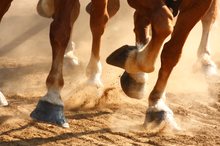According to Allison Stewart, DVM, Dipl. ACVS, an associate professor at the University of Illinois, "About half of all horse farms have at least one horse with OA or a lameness issue."

The vulnerability of a horse's legs
Osteoarthritis causes lameness and can lead to the debilitating, premature end of a race or working horse's career making the disease a top priority for equine practitioners.
The risk of developing OA increases with intensity and duration of exercise, years in training, time spent on hard ground, and the amount of jumping exercise. Concussive forces, or violent shocks to a joint, involved in many equestrian sports leave the horse vulnerable over time.
It is well known that diagnosing and treating equine osteoarthritis (OA) is a top priority for many equine practitioners. The disease causes lameness and can lead to the debilitating, premature end of a race or working horse's career. By the time clinical signs appear such as swelling, heat over the joint, pain, loss of flexion, damage hs already occurred to the horse's cartilage.
The use of modern diagnostic systems is important to identifying stifle, foot damage, or laminitis which are secondary to OA. Radiographs and MRIs are usually necessary for a definitive diagnosis. Although radiographs are most cost effective, MRIs show more detail such as bone changes and reduced or increased signal in the cartiage. Arthroscopy is also helpful in discovering damage to cartilage, but is more invasive.
"Testing synovial fluid for an increased mononuclear cell count increase can evaluate for differential cellular counts, pH, total protein concentration and mucin precipitate quality," says Dr. Stewart.
"Isolating the lameness area and identifying its cause is the first step in a treatment plan," according to Dr. Stewart. "Sometimes a diagnosis route is determined by the client's budget. If the client has limited funds, I allocate the money for use in treatment more heavily than additional diagnostics."
Experts say that although treatment options are better now than ever, they're hopeful a better way to prevent and treat OA will be developed - perhaps through a combination of dietary benefits known today and biologic treatment still being unraveled.
Minimizing the number of cases of osteoarthritis and taking steps to prevent its development should be a priority for every horse owner. Simple steps such as icing a horse's limbs after strenuous workouts and making sure that surfaces in stalls and paddocks are kept in good condition to prevent injuries are things every horse owner can do.
Making sure horses are properly shod along with regular farrier visits can help not only prevent lameness leading to osteoarthritis, but can also minimize conditions that might lead to the condition.
According to Dr. Stewart, 'The wave of the future is more preventive in nature. I don't know if supplements will play a role, but it would be ideal and more scientific to inject supplements because we know it will be better absorbed than if taken orally."
